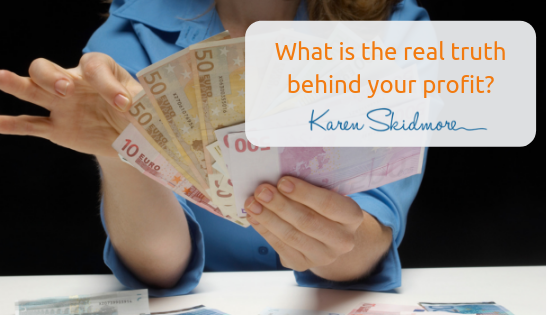
by Karen Skidmore | 05,19 | Marketing Articles, True Profit
For many of you who decide to start up a business, it isn’t the money that necessarily drives you above all else. However, making sales is a critical component to having a successful business. Without someone buying what it is you are selling, you have no business. Even a charity or not-for-profit organisation has to have an income to exist to do its work.
There’s often a lot of emotional baggage and over-thinking tied up with the process of sales and marketing, especially when money may not appear to be the primary driver. Feelings, beliefs, and thoughts about money and profit often create strong emotions and thinking around what you believe you are worth, the prices you charge and your ability to go out and sell.
You will have your own stories about what profit means to you.
Profiting can be viewed as a “bad” thing to do in business for a lot of people. I have heard many stories over the years from my clients about money; about how they base their behaviour on beliefs such as “I need to add more bonuses and get everything right before I put my offer out there”, “my clients wouldn’t pay those kinds of prices” or “I want my prices to be low enough for anyone to say yes”.
When you focus hard at making sales
The times that I have focused hard on making sales have been the unhappiest and most stressful months of running my business. I remember one period in particular when I decided to work with a sales mentor because I was frustrated with my inability to make enough money. I had convinced myself (and he had convinced me, too!) that he had the sales formula that would solve all my problems in just six weeks. He taught me a sales strategy that I now refer to as FOOB (F*%! Off Or Buy). The selling process meant that the offer I made on a call with a prospect was only available if the person decided to buy there and then. If they wanted to go away and think about it, that was OK but they wouldn’t get the special price I was offering to them. I was being taught to sell scarcity in a high-pressure sales environment so that I could make my sales targets.
I made my targets and I filled my programme, so you could say it worked. But I was miserable making my sales this way. It felt pressurised, the process didn’t align with my values and I soon decided to stop working with this particular mentor.
Each time I have found myself rising to the pressure of having to make money, it has rarely worked. Even when I have met my sales targets in this driven way, I didn’t seem to be any happier overall. My sales achievements often pushed me to up my game and increase my next month’s targets, I didn’t take the time to celebrate my successes and just raced on to the next idea or project. All this contributed to my burnout.
When you focus hard at doing anything but making sales
On the other end of the scale, there have been times that I have done anything but do the work to make the sales. When I first started up my business, I often used the phrase “I’m not doing this for the money”. I had stories going on in head such as “I’m just a mum who works from home” and “I need people to like me before they buy from me”. I was pretending to myself that money wasn’t important and these stories held me back. I felt incredibly uncomfortable when quoting my prices. I just hoped that my emails and blog posts would do the selling for me, rather than pick up the phone and speak to people directly (which frankly is still the simplest and easiest way to make sales today).
This would also happen during the times I was burning out; being knackered and brain fogged meant that my fears and doubts would have me spending my time re-writing my sales pages, creating pretty graphics, writing email autoresponders and posting updates on my social feeds. That’s all I felt I was capable of so I found myself busy for the sake of being busy because I didn’t have the energy to plan long term or think strategically about my business.
So when you focus hard to make sales, you are in danger of working against your values or lose sight of your purpose that can mean, over time, you burn out in the process. On the other end of the scale, if you aren’t connected with your purpose or your money stories are triggering your fears and doubts, your business has the danger of being nothing more than an expensive hobby.
What are you do?
Do we really have to sacrifice our creativity and purpose in order to make a profit?
What I have come to know now is that for you to fulfill your greatest potential and play your bigger game, your business needs to fuel three things: your creativity, your purpose and your financial goals. This is not an “either-or” choice you have to make. You can have a business that fulfills your purpose, allows you to have fun as well as make good money in the process.
A 6-figure business with a turnover of £250,000 may sound impressive, but when you see the business owner burnt out, unable to feel fulfilled or even pay themselves a decent income because their costs are so high, the True Profit of this business is low.
A business with half this turnover, but with the business owner working in flow and having decided that a £65,000 annual income is more than enough to give them what they want from life, the True Profit of the business may be considered high.
Everyone will have their own, unique True Profit figure and it’s important to recognise this. We often judge other people’s businesses from what we see externally; the number of people in the room at a conference or how many likes or comments they get on their Facebook posts. And then we use these judgments to benchmark our own success. But the external numbers only tell one part of the story.
Profit
Let’s dive into the topic of profit in more detail. If you look up the definition of profit, this is what you’ll find:
“The monetary surplus left to a producer or employer after deducting wages, rent, cost of raw materials, etc”
Now, I don’t know about you, but that definition is not terribly inspiring to me. When laid out like this, it’s easy to think that profit is best left for your accountant to sort out at the end of each year. Having a “monetary surplus” is hardly inspirational.
Even though I recognise the fact that making money is important, I’ve never been particularly motivated by numbers on a spreadsheet. In my early years, knowing what my profit was week in week out was never high on my agenda. I knew what my sales were (turnover) but never really bothered by what my “monetary surplus” was. They were even times where I would totally disregard the financial aspect of my business which, not surprisingly, did lead to the detriment of how much money I really did make. My sales may have been good but what this translated into profit and my personal income has been demotivating at times.
What does the word profit really mean?
A business like mine and yours is not just something we do; it’s not a job that we get hired for but a representation of who we are. No matter what you sell, you have so much of you wrapped up in it (your expertise, talents and intellectual property). This can make it hard to separate the pragmatic, monetary side of worth, with the worth that’s wrapped up so tightly in your heart, body, and soul.
This is why it’s interesting to look at the origins of the word profit because it has a completely different meaning to what we think of profit today. Go back to 1300 and the word profit comes from the old French “prufit, porfit”, meaning “benefit advantage”. If we go further back, the word profit comes from the Latin word “proficere”, which means “accomplish, make progress, be useful, do good, have success.”
Our modern-day economy has seemingly sucked the life-force out of the word. Profit is no longer associated with accomplishment and commitment to do good. The doingness of our business culture has morphed the word “profit” to give us a different version of success; a version that makes us feel we are never enough.
It’s time to change this. You, and all our micro-business and small business communities across the globe, have a huge combined economic power, as well as the ability to make our own choices in how we decide to grow our business, which in turn can change the way business impacts our planet and how we treat each other as human beings. Profit can once again mean that business is here to make progress, to be useful and does good.
That’s my bigger vision and my driving purpose for my business and the work that I do. But with as with most bigger visions, a mission such as this grows with one business at a time. So, let’s start with your business. Let’s dive into how you can bring these principles of True Profit Business into your business.
A new (and better!) way of doing business
The True Profit Business Model
We’ve established that financial profit is important; let’s not pretend otherwise. Without money flowing into your business, money can’t flow out. It’s a necessary energy to create growth. But take into account the hours you work, the effort you put in, the sacrifices you make, the stress that your business causes you … how does that financial figure translate into your health, wellness, happiness, time and impact that you make?
I believe that when you figure out how, when and where you want to work, get clear on your strengths and values, and design the right marketing systems, revenue streams and business model that fuels you, that this is when a True Profit Business Model can give you freedom to create, have an impact, as well make you money.
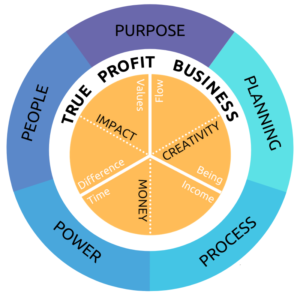
In the center of the True Profit Business Model are the three energies of money, creativity, and impact. It may not feel like it right now, but you have complete control over the choices of how each of these energies can work for you. Deciding on what these choices become your True Profit Compass, a navigation tool to help keep you centered on how your business works for you at each stage of your business growth journey. Your True Profit Compass evolves over time as you grow and evolve so it’s a tool you will want to review a few times a year and particularly before you create any next growth plan or make a decision to change the way you run your business.
Surrounding your True Profit Compass are the five True Profit Growth Pillars, which are there to support you at every stage of your growth. These pillars have to grow together because, as you can imagine, if even just one or two are not growing with you, you are going to have wobbly foundations for your business.
Over the coming weeks, I shall be sharing more about these five Growth Pillars and the True Profit Compass. My new book, True Profit Business, is coming out this September.
In the meanwhile, I’d love to know what insights you have this article so do comment below and share your thoughts on what profit really means to you.
Thank you for reading. Until next time, do less, be more, play bigger.

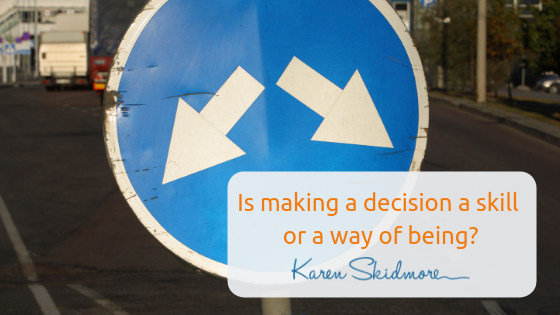
by Karen Skidmore | 02,19 | Marketing Articles, Pillar Articles
The number of choices you have to make to each and every day can add up into the thousands; from what clothes you put on in the morning and what you eat for lunch to what podcast you listen to next or radio station you play in the car. In fact, some sources claim that we make up to 35,000 decisions every day.
So it’s no surprise that, when it comes to making decisions about your business and marketing, that decision fatigue can become a real problem. If you’re already facing a thousand or more decisions about day-to-day stuff, when you apply the same decision making process to bigger business and marketing stuff, your brain can be running tired and wired.
It’s like having too many tabs open on your browser or too many apps running in the background of your phone … because your brain is full of mundane thinking, it just doesn’t have the capacity to move up a gear to deal with the seemingly bigger or more important decisions about your business.
I believe decision making to be one of the “secrets” to business success. It’s action, rather than ideas, that grow your business and action can only happen once you’ve made a decision.
So if you find it difficult to make decisions, it can really hold you back in your business growth journey.
 Many years ago I came up with The P Cycle; the constant and exhausting swirl of perpetual learning, which leads to perfectionism, which leads to procrastination which leads straight back to perpetual learning.
Many years ago I came up with The P Cycle; the constant and exhausting swirl of perpetual learning, which leads to perfectionism, which leads to procrastination which leads straight back to perpetual learning.
Because when you don’t know something (which is ALWAYS the case with most of your business and marketing decision, yes?!), it feels easier to go out and learn more about whatever it is you are making a decision about first, before actually making a decision to take action on it.
This means you are forever seeking ideas and learning more about how to do something … but you never quite get out of The P Cycle to take actual action and move forward with your business idea or marketing initiative.
So is decision making a skill you can learn?
Yes, sure it is. You can use tools such as the classic SWOT or cost-benefit analysis to help you weigh up the pros and cons.
But for most of your decisions you have to make to move forward with your business or marketing, I’ve found many of these decisions making tools have the danger of keeping you in the P Cycle.
Because you go off and learn how to make a decision, you try and get the decision making process right (AKA perfect!) which delays the decision making process even further and thus stops you from taking action.
Is there another way of making a decision?
Yes. I’m glad you asked 🙂
Because there is an important space within us that very few of us know how to access on a day-to-day basis.
You probably feel it from time to time and perhaps, like me, you know it’s there because so many people around you refer to it. Some people call it a gut feeling. Others may call it intuition. It doesn’t really matter whether you may feel it or hear it in your gut, soul, heart or solar plexus, it’s the thoughts and feelings that come to you when you may meet someone for the first time or walk into a room or in the middle of a conversation with someone.
Having spent the first 25+ years of my adult life as a strong, independent Super Woman (yup, I really was on track to burn out by the time I got to 43 – I just didn’t see it coming!), I really didn’t know how to access this intuitive way to help me make decisions. I was so busy making decisions based on logical thinking, that it was burning me out. Just like that browser with too many tabs open; at some point, you are painstakingly watching yet another spinning circle of doom that you realise the only thing you can do is re-boot the whole of your machine.
So a few years ago, I decided I need to re-boot, slow down and explore different ways of growing and building businesses.
 Let me hand you over to my good buddy, Kate Wolf, who is an expert on this matter.
Let me hand you over to my good buddy, Kate Wolf, who is an expert on this matter.
“Everyone is designed differently which means we all ‘hear’ our intuition in different ways. Some people hear words or phrases, for others, it’s a ‘feeling’ or sixth-sense. And for others, it’s an actual physical feeling or sensation in the body.
The key is to take the time to discover how your intuition speaks to you. The more you ‘listen’, the more you’ll ‘hear’. It’s also a journey of trust and courage. As you start honouring your intuition and daring to act on it, it will show up more for you and your relationship will strengthen.
Often people think they’re not intuitive but when I ask them to tell me a time they ‘just knew’ something was the wrong decision for them – whether it’s in the realm of business, finance, relationships, health or pretty much anything – everyone can come up with something.”
So if you’d like to find a way of accessing your intuition more to help you make decisions more easily – and thus take action on the stuff that’s going to grow your business – here’s what I love to invite you to do.
Learn to be a tracker of how your intuition shows up.
I’ve been on a huge journey over the last few years, re-connecting with myself and discovering how our energies work. I have had to learn how to slow down so that I may hear what my body and soul is trying to tell me.
A couple of the regular practices I use to allow myself to track how my own intuition comes up are are journalling – the simple practice of writing a few pages of my thoughts before I start my working day – and using Angel Cards – picking a card before or during my journaling to help me bring awareness to what I should be paying attention to. Both these practices allow me to get out of my head and feel into different parts of my body and awareness. And from here, I can pay attention to source rather than the exhausting logic.
There’s so much more I want to share about this topic but I want to finish off today with these final thoughts from Kate.
“It can be very easy to mistake projection for intuition. One of the key ways to recognise your intuition is that it comes without a story. If you find yourself explaining WHY something is so, and telling yourself lots of stories about it, it’s almost definitely some form of projection. Intuition simply is. It doesn’t need to explain itself, rationalise or justify.
So if your ‘sense’ or ‘feeling’ is coming with a lot of story and explanations, it may well NOT be intuition. When this happens, take some time to meditate, to journal, to get beneath the story to the truth. This is also a good time to turn to a skilled Coach or Healer who will guide you out of the story-mess of your head and into the wisdom of your body.”
I find I can use stories A LOT in my thinking when I’m running my decisions purely on logic, which is helpful when working with my clients because I can see them do exactly the same thing LOL. So this is great advice from Kate, particularly if these kind of practices are new to you.
If you have anything to add to this, please leave a comment below. I’d love to know how this article shows up for you and what you do to help you access your intuition.
Thank you for reading. Until next time, do less, be more, play bigger.

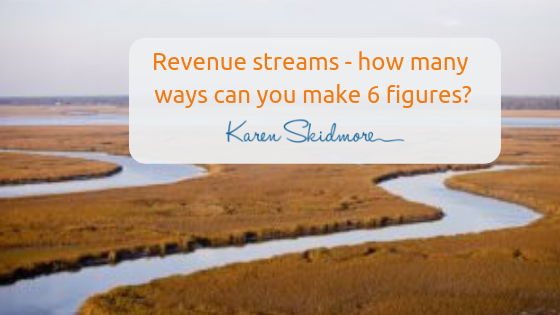
by Karen Skidmore | 01,19 | Marketing Articles, Pillar Articles
No, it’s not a trick question nor am I about to launch into some scammy way of turning on a money tap whilst lounging back on a Caribbean sundeck. It’s a serious question that all experts and service-based professionals need to answer at some point in their business.
Of course, the sum doesn’t have to be 6 figures. If you read my book, True Profit Business, you’ll discover that I am not a fan of pushing out the 6 figure business dream; it’s an ego-driven target because the reality is that most “6 figures” mean some an entirely different money-in-your-bank-account-sum when you take into account exactly what profit you made and what you sacrificed to get it.
Too many people are simply burning out to achieve the wrong goals.
If it is a genuine 6-figure sum you’re after, great, but the money sum could be that you simply want an extra £10,000 over the next few months. For the sake of simplicity, the money sum I’m going to use in this article is £100,000 because it’s as an easy number to work through.
First of all, why is this question important?
Knowing how you want to make your money from your business is important because it’s going to significantly impact your marketing strategy, positioning required, resources needed (advertising budget, hiring of team, cost of digital platform set up), skills to learn and how much time and effort you are required to get it all working.
Your business model – how you shape your revenue streams and how you engage with your clients and deliver your products – is directly related to how well you can grow your business. You may not have realised this before now, but you have a choice in the way your design, set up and run your business. Most people like yourself end up with a business model based on what everyone else in your profession is running or a business model based on what you’ve been taught to be the most profitable or easiest to run.
In the first instance, you may have the same business model as everyone else in your profession not because of choice, but because you don’t know any better. What you don’t know, you don’t know and, as with most clients I work, I doubt you’ve gone to business school or have training in business processes and systems.
If this is the case, you may have spent a lot of time learning about marketing and how to get clients but the topic of how to design, set up and run your business is something you’ve probably never given much thought to. Doing what everyone else in your profession does has its upsides because you know what works already. However, there is a big problem with this.
Just because most of your colleagues or competitors are running their business in a particular way, it doesn’t necessarily mean they are all doing it the right way for them. If we take the Pareto Principle that statistically proves 80% of your outcome comes from 20% of your input, 80% of the success that happens in your profession comes from just 20% of the businesses. Thus 80% of businesses in your profession is creating just 20% of the output.
Hmmmmmm. No wonder so many of your colleagues and competitors seem to be struggling when you get to see what’s really going on behind their marketing, promotional campaigns and brand presence.
You know if you are in the 80 percentile if you experience any of the following:
- You’re overwhelmed; you’re procrastinating over marketing initiatives and new product ideas because you simply don’t know what you “should” be doing to make your business work more effectively.
- You’re overworked; you are stuck in the day-to-day grind and feeling miserable that you can’t spend the time doing more of what you love
- You’re underpaid; you compete on price, charge by the hour or the time you spend with a client and often over-deliver so that you do far more than you originally promised thus dropping your value even further.
I know this paints a pretty depressing picture but there are plenty of you in this situation (you are part of the 80%!) and if you get a copy of my book, True Profit Business, you’ll discover the path out of this 80%.
What are the top 20% of your profession are doing to have a greater output?
There will be of course all sorts of reasons for their success but there is every chance that they are using technology to create huge growth advantage opportunities to allow them to stand out as a leading expert in your profession. You’ve probably already seen colleagues and competitors create new ways of sharing their expertise. From expanding their offerings to serving groups of clients, large and small, through to creating digital content and using cutting edge use of artificial intelligence; the opportunities to do something “different” and grow the number of clients you work with are open to you if that’s what you want.
This leads me to the second instance where many of you may be. The explosion in selling digital content since 2015 has led to thousands of marketing experts teaching digital ways of making money and growing a business from your laptop on the beach, particularly within the coaching, therapy and training professions. Because technology has been the reason for a lot of businesses’ success, it’s easy to get sucked into believing that digital is the only way to grow a business like yours. But that’s not simply the case.
Many marketplaces are now so flooded with digital offerings that it’s hard to break in and claim your space, especially when so much of the content can be of poor quality and your client base may have begun to distrust this form of learning or support. Plus there are plenty of those 20% businesses in your profession who are running more traditional business models, but because you don’t get to see their marketing campaigns or brand presence on your Facebook or Instagram feed, you may not realise they exist.
And let’s get real about how it is to run a top 20% business. You may have a business that, on paper, is well within your profession’s top 20%, especially if you are measuring its success on traditional key performance indicators such as turnover. But the reality of running your business in the top 20% is that it may be burning you out.
You know if you are getting burnt out in the 20% if you experience any of the following:
- You’re overwhelmed; you’ve stepped up and created your expert status but you don’t like the visibility and constant pressure to perform.
- You’re overworked; you can’t seem to keep up what you’ve promised your clients and can’t come up for air long enough to hire the right people to help you grow.
- You’re underpaid; your turnover maybe 6 or 7 figures but there’s not much left for you once you’ve paid your team, advertising invoices and running costs.
Again, another pretty depressing picture. But as before, you aren’t the only one to have created a business that is burning you out because this practice of growing a business based on following someone else’s formulas and business model is rife. This is why I want to open up your eyes and see the possibilities available to you on your path to creating a True Profit Business. My mission here is to help you to avoid following someone else’s proven business model and systems, just because they are telling you it works for them.
You have a choice.
You have a choice on what business infrastructure, processes and team to have in place to give you the right business to help you achieve your creativity, purpose and money aspirations. You can choose the design, set up and how you run your business based on who you are and how you want to show up, just the way you can decide on the right vehicle you want to drive day-to-day.
The reason why there are so many different types of vehicles on the road is that each and every one of us has a different reason for choosing our mode of transport, and at different stages of our lives. Starting out, you’ll drive any car you can afford; a small hatchback or perhaps stick to your bike, especially if you live in a city. Families may drive a big SUV. Some may like fast cars. Others choose their mode of transport based on environmental impact and may even decide they don’t want to own a vehicle but use uber or rental cars for longer journeys.
There’s no one vehicle that’s right for everyone or for a specific profession.
And so it is with your business model.
There are four critical decisions to make to help you decide which business model you want; your role in the business, the number of clients you want to serve and then consequently at what price point, how you deliver your service or products and which selling system you decide works best for you. In my book, True Profit Business, I am taking you through in detail all four of these decisions. So for now, let me take you through a couple of examples.
The passive income dream.
Someone I spoke to recently had recently spent a significant amount of her investment cash setting up a new membership website. She had read a lot about membership sites, had joined an online business mentoring programme to teach her the basics of setting up digital products and thought this would prove to be a perfect revenue stream to have around being a mum at home with two young children. She wouldn’t have to travel anywhere and she could do everything her business needed her to do from her kitchen table.
There was no questioning her passion for helping the audience she wanted to reach out; she knew they were desperate for clear signposting and easy to access advice. But 14 months in and her beautifully designed website was verging on a marketing disaster. Although visits to the site were climbing and she was good traction in the forums, database building was almost non-existent and her offer just wasn’t compelling enough.
Her plan was to start with the freemium model and then start charging £27 a month. She had dreams to have a 6-figure business but to make £100,000 that would mean 309 members, assuming that all 309 would stay a minimum of 12 months. That’s a whole lot of leads to get that many customers, and a whole lot of customer retention strategy to keep them being members.
Of course, long term this kind of membership model can work but you need a big bucket of resources (advertising, customer support, time, energy and hours and hours of screen time) because your marketing strategy is focused on high volume, low pricing model. It’s highly unlikely that any decent profit will be made for at least a year or two (probably many more!) if you are relying solely on this kind of revenue model. And this person was burnt out already after 14 months of struggling to build up her tribe on a bootstrap budget and a lack of skills around digital marketing and advertising.
Let’s go the other end of the scale.
A client I worked with recently came from many years in the publishing industry. Now I am sure you are aware of the massive changes that have turned much of the publishing sector on its head. The problem she was still stuck in the traditional, old school business model where very little revenue was created until a book was published and selling. For her business to make £100,000, it was all about book contracts; working hard upfront and only seeing rewards when (and sometimes only if) the book was successful. Plus it was a cost-heavy business so profits were tight.
When we starting diving into the process she went through with her author clients, it was apparent to me, almost immediately, the value of what she did even before the content was written. Of course, being surrounded with the traditional – and very much outdated – publishing business model, it was a classic case of “what you don’t know, you don’t know.” But having talked through all her options and what role, client capacity and delivery process would work for her, it was as if a searchlight was beaming through the fog and a new path became clear.
Offering her services as a book coach and mentor at the start of the process was an obvious place to begin; charging for the 6 months run-up to get the book ready for editing was not only profitable for my client but incredibly powerful and instrumental for the success of her author clients. Again, not a holy grail solution to making 6-figures – there was still a lot of thinking and doing to be done around her positioning and marketing her new offerings – but she could see clearly that this additional revenue stream could be a far simpler way of growing her business revenue than sticking to what everyone else in her industry did.
And without distracting her from her core revenue base or burning herself in the process.
The price you decide to charge has a lot to do with your success.
Before I send you off to have a think about your potential revenue streams, let’s deal with the elephant in the room; the price you charge. When creating new revenue streams in your business, it’s often perceived easier to start at the lower end of charge of the price scale. I’m sure you have seen, and perhaps even bought from, the classic product funnel that gets you started with a £10 introductory product, which leads into a £295 course and then takes you into a premium programme of £1,000 and more.
So what many do, and are taught to do, is start creating your £10 introductory offer because you believe you need to build your list. And a £10 product is so much easier and safer to create, is it not?
Coming back to the question on hand – how do you go about creating £100,000 … that’s a lot of £10 sales you need to make to build enough momentum to move people up to your next mid-level product. You’d probably be needing 500+ sales to get you the conversions to that £100,000. That’s exhausting (and I speak from experience!)
Again, like the membership offer example above, this kind of product funnel works. There’s no doubt about it. But starting with the perceived easier end of the funnel is not always your easiest path to growing your business. A far quicker, simpler and easier way can be to flip your funnel on its head and start at the top end of the scale. Even if you decided to start small and create a programme or service at around the £2,000 mark, it becomes obvious that you have to sell to far fewer people to get yourself to your £100,000 goal. Plus you’ll gain valuable experience, build your credibility and see better results from your clients working at this level.
Now, of course, I’m starting to sound like the rainbow fairy.
“Just wave your wand, burn your candles and the unicorn will come and poop out those clients for you.”
You know clients aren’t going to magically appear with intention alone (don’t you?!). There is focus needed for your overall strategy and positioning, a clear offer created and an understanding of what your market place really wants. But I hope that you get the point that I am making here and that you realise you have a choice about how you design, create and run your revenue streams in your business.
Think carefully about your pricing and offers as you grow your business.
Don’t just follow someone else’s system that they are selling you or stick to what your industry does best, because it’s not always the case. Start with where you want to go in your journey and what income and impact goals you want.
Thank you for reading. Until next time, do less, be more, play bigger.

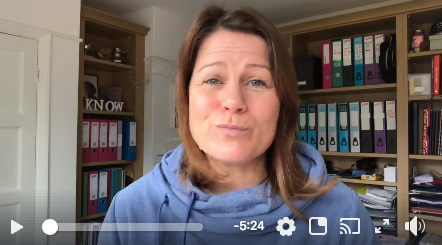
by Karen Skidmore | 02,18 | Marketing Articles, Videos
When bootstrapping hurts your business
How can you ensure your marketing reflects the value of what it is you’re selling?
Marketing costs. There’s no denying it.
Hard cash, your time, resources – whatever way you look at it, it costs to market your business.
So I get that the popular questions I get asked about marketing are versions of “what the cheapest, quickest or easiest way to get my next clients?”
Bootstrapping mindset.
Sometimes critical. But often a dangerous place to stay for any length of time.
In today’s vlog, I’ll give you an example and share the three key questions you are responsible for answering, as the marketer of your business.
If you’re bootstrapping, email may be your first choice of communication over and above direct mail. A letter in the post is always going to be far more expensive to produce, print and deliver than a single email.
Email is going to be the cheapest, quickest and probably the easiest way to market your new service, programme or workshop.
But is the most effective? And does it reflect the value of what it is you are selling?
Let’s say you’re wanting to invite HR Directors and Managers along to a seminar you’re running. Will they get to see that email you send them? Probably not. And if they do, what’s their response going to be? Click, delete?
If on the other hand, they received a letter in the post. A well put together invitation with a booking form. Would they see this? Probably, yes. But if they’re busy or it comes in the post along with a dozen other brochures and sales letters, your message may get lost.
And if they do see it and read it, what reaction do you think they’ll have? Maybe interested, but would it be compelling enough for them to respond?
Let’s take your marketing up a notch. What if you sent a big package in the post? And you sent it overnight by courier and it needed a signature on delivery? A box containing a beautifully crafted brochure, the same invitation to attend that seminar and possibly a treat such chocolate. Obviously far more expensive and thought needed to send, but will they see your message? I’d say almost definitely. And if they did, what’s their response going to be?
Obviously, you can’t guarantee that the person receiving that package in the post is going to be your next client but you can guarantee that you’ll get seen and that they will have an opinion about the level of service you offer.
As a marketer of your business, you are responsible for answering these 3 questions:
- What’s the message your prospects want to hear from you?
- How do you get your message noticed by the right people?
- How do you get the right people to respond and take action on your message?
Bootstrapping puts blinkers on you when you try to answer these questions. So even if you aren’t trying to be cheap, but you’re trying to be quick and easy … you’ll not be going to do the right thinking around answering these questions.
As noise levels are at an all-time high now for most of your prospects, you simply can’t afford to do cheap, quick and easy anymore. You’ll lose out.
It doesn’t necessarily mean you have to spend bucket loads of cash to make your marketing work, but you do need to spend time and resources on the thinking around your marketing.
Let me know what kind of marketing campaigns you’re putting together? Are you going beyond the cheap, quick and simple email? I’d love to know,
Thank you for reading. Until next time, do less, be more, play bigger.

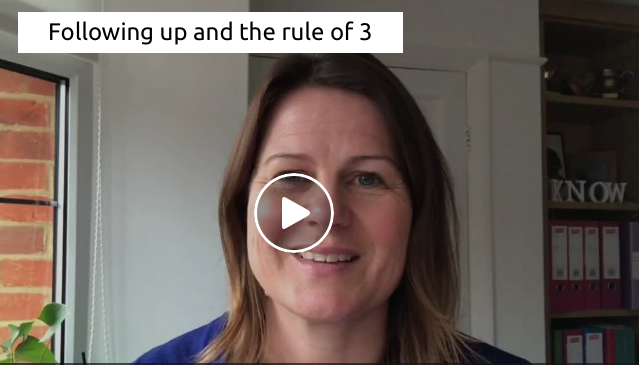
by Karen Skidmore | 02,18 | Marketing Articles, Videos
Following up and the rule of 3
The art of following up. Why it’s critical to follow up, why you don’t follow up and how you can follow up simply and easily without an overcomplicated online funnel that drives you nuts in trying to set the whole thing up.
Following up leads and prospects is critical to the success of your business. If you’re going to go to the effort of building a list of subscribers to try and find new clients, then following up on anyone who shows an interest in what it is you offer should be part of your weekly – if not daily – marketing activity.
And yet, why don’t you follow up?
The art of the follow up. Why it’s critical to follow up, why you don’t follow up and how you can create a simple and easy follow up process and avoid an over complicated funnel that drives you nuts in trying to set the whole thing up. Until next time, do less, be more and play bigger x
Posted by Karen Skidmore – True Profit Business on Wednesday, February 14, 2018
There are 3 main reasons why business owners don’t follow up.
1) You let the process become too emotional – there can be a lot of fear attached to following up – fear of being rejected – fear of being humiliated – so if you let yourself listen to these fears too much, you make up stories why you shouldn’t follow up. “I don’t want to pester them – they know where I am if they need me” … which actually makes no sense because you have no idea whether they are too busy for you and you certainly can’t be assuming that they know where you are if they do need you.
2) You don’t have a system to follow so when you get busy, you forget. If you keep the names of people of you’ve spoken to or emailed in your head or on a to-do list somewhere, it’s no surprise that you find yourself two months later after an initial phone call, and you never scheduled in a follow up in your diary.
3) You over-complicate the process by trying to build online funnels with upsells, down sells, double opt-ins and autoresponder sequences. I see this one a lot because the creative brain of an entrepreneur is attracted to shiny shiny and it’s also far easier to distract yourself with creating landing pages and writing emails than it is to pick up the phone.
So can you see how you can distract yourself from the actual process of following up?
To make sure your follow-ups happen you need to create a repeatable, simple process.
And if you can delegate this process, then even better.
With all follow-up processes, I teach the power of 3.
3 emails, 3 letters, 3 phone calls, 3 messages.
3 is enough to send out over a two week period without being a pest. And 3 is enough for you to create, write and execute without it becoming a huge project.
Often I have people ask me about autoresponders with 10 or emails in them. Or they want to create a 6 month follow up.
But make this too big, and you’ll never find the time to complete it.
So start with 3 emails,3 letters or 3 messages over a two week period to begin with. You decide which form of communication is going to be best of your prospect.
If they don’t respond to any of the 3 within that time period, then put them back into the prospect pot and try a different approach next month.
So if you’ve sent them 3 letters, then the next month try 3 phone calls. If you’ve tried phone calls, try 3 special delivery parcels next month.
The important thing in following up is that you keep following up, even when you get a no.
Because a no is often where the conversation starts and a no now, may mean a yes in a few months time.
Finally, I want to make sure you keep track of your prospects that you’re following up. As I’ve mentioned already, keep these in your head or rely on your inbox to keep track of them and you will forget.
There are a tonne of online CRM systems so if you want to subscribe to one of these – do it. But before you distract yourself with a new tool, often the best place, to begin with, is a spreadsheet.
Name, contact details, date of initial contact and date of next follow up – keep it simple and you’ve got a place to go to at the start of each new week so you know who needs what from you.
Thank you for reading. Until next time, do less, be more, play bigger.


by Karen Skidmore | 11,17 | Marketing Articles
Don’t squeeze me too hard
What do you do when you have a new idea? Not just any idea but the kind of idea that catches you off guard … gives you that flash of inspiration. You feel exhilarated and your eyes shine brightly with opportunity.
What happens when you start to think about getting that idea turned into reality? Do you fly by the seat of your pants, take big action and strike whilst the iron is hot?
But what if you take on too much and realise you are spinning way too many plates as the idea slips down your to-do list. Perhaps the idea sounded great in your head but now that you’ve said it out loud, it feels too big and scary and you talk yourself out of it.
Several years ago, I found myself burnt out from taking big action on new ideas after following the traditional SMART goal setting tools and work-harder mentality. It was quite frankly exhausting. Specific, measurable, achievable, realistic and to a timescale … my head starts hurting again just thinking about this stalwart of planning tools.
After years of playing SuperWoman and pushing hard on my ideas to turn them into action (and yes, the big pants over my jeans was a never a good look), I went the other way in extreme. I was burnt out and all I could do was try to free flow it, pretending I didn’t really care about the outcomes but then getting anxious and stressed when I didn’t make the sales I had expected.
What I teach my clients today is a balance in the middle of these two places.
SMART push energy and work-harder mentality can burn you and your big ideas out. Squeeze too hard and you squeeze the life out of your idea.
However, the other extreme of free flow and expecting the unicorns to listen to your daily mantras and poop success out onto your desk without taking any action, doesn’t cut it either.
It’s a fine and delicate balance of holding your idea lightly enough to be playful and curious, whilst formulating a plan to take action in a considered and inspired way.
Now before you think I’ve gone all woo woo on you, let me bring you back to planning.
The style of planning I teach today is way different to what I use to practice and preach five years ago. Gone is the SMART goal setting but it’s still highly focused and action orientated Here are the 3 key differences.
- Less is more. One of the problems that a highly creative brain gives you is the endless stream of ideas. You often get stuck on the “How?” question but rarely on the “What if?” But too many What If’s and it can spin you out of control, as the ideas that come out of you multiply and before you know it, you’ve got a dozen or more projects on the go. It’s why you never quite finish that online course or get started on your book or finish your website if you’re trying to “do it all and more”.
So when it comes to planning out your ideas for your business, it’s important to break your planning periods down into 90 days. 90 days is a perfect timeframe to keep you focused on doable actions whilst being far enough in the future to allow you get some serious shit done.
Then the secret to making these 90 days work is to have no more than 3 projects or inspiration ideas to focus on. I do allow my clients to go up to 5 but at least 2 of these projects must be outsourced or delegated to another person to take action on.
There is Gary Keller’s One Thing theory that I know a lot of people love but for me and many of my clients, having only one thing can feel rather constrictive. I thrive on variety, so I’ve discovered that I need more than One Thing to keep me motivated, But more than 3 and overwhelm sets in and I squeeze too hard on my ideas.
- Be playful and unattached. When you fly with a new idea it’s easy to get attached to the outcome. SMART goal setting is all about outcomes as you have to get uber clear on exactly what you want to achieve. The problem I’ve experienced with this approach is that I get so hung up on getting the SMART goal that SuperWoman kicks in with gusto. I push and make things happen which can work for a short while but over a longer period time, burns me out. And because I’m so focused on the end result, it’s easy to ignore or miss out on easier, simpler or better opportunities to allow the idea to come to life.
When you take the playful and unattached path, you can actually enjoy the journey. The planning I teach is about breaking down your journey by milestones and signposts rather than strict target setting. The analogy I use is deciding which city to fly into at each leg of your journey but not getting hung by the terminal or the seat number you’ve got to sit in to get there.
- Be brave. The best ideas are the ones that scare you, ever so lightly. You feel a tightening somewhere in your body when you tell someone your idea. A slight rush of adrenalin or anxious thoughts rise up … not so much that you freeze or turn into a bubbling wreck … but just enough for your inner critic to say “Hang on … did you just say that? Are you sure? You could fail, you know. You could end up looking stupid if it doesn’t work out.”
Your inner critic wants to protect you and keep you safe. And in order to do that, it prefers you play small. Now playing big doesn’t always mean big, hairy audacious goals. You don’t have to change the world or turn your business into a 7-figure empire with 10+ employees. If you do, great. But the less you worry about comparisons and being guilt-tripped into taking action on “should-do” ideas, the happier you will be. Believe it or not, you DON’T have to have a regular passive income or a huge list of tens of thousands or stop selling your time for money to have a successful business.
Now I know not everyone agrees with me on this, but the clients I work with find it incredibly refreshing that I advocate going after dreams and business goals that fit their life values, family, health and wellbeing. Be brave and get visible but there is no real need to chase someone else’s dreams.
If you want to know more about the style of business planning I teach, then email me at [email protected] or give my office a call on 01428 607745. We can set up a time to speak and I’m happy to share more of my ideas with you and answer your questions.
The important message I want you to take from this is for you to hold your bright and shiny idea for your business in such a way it’s as if you are holding a ball of light. Play with it. Feel it’s energy. Throw it up in the air and see how it falls from time to time.
But just don’t squeeze it tight.
Know where you’d like to go with it. Visualise the outcome and allow it to be as big as you comfortably feel stretched. But keep your action taking in flow and allow opportunities to open to you. Enjoy the journey of making it happen rather than push hard and get burnt out.





 Many years ago I came up with The P Cycle; the constant and exhausting swirl of perpetual learning, which leads to perfectionism, which leads to procrastination which leads straight back to perpetual learning.
Many years ago I came up with The P Cycle; the constant and exhausting swirl of perpetual learning, which leads to perfectionism, which leads to procrastination which leads straight back to perpetual learning.  Let me hand you over to my good buddy, Kate Wolf, who is an expert on this matter.
Let me hand you over to my good buddy, Kate Wolf, who is an expert on this matter. 








